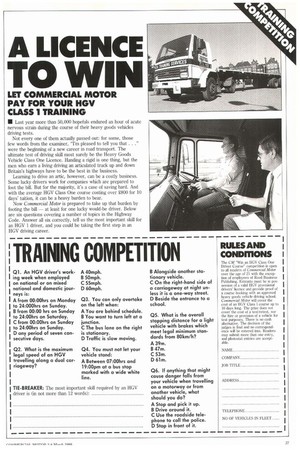TR AINING COMPETITION
Page 39

If you've noticed an error in this article please click here to report it so we can fix it.
Ql. An HGV driver's working week when employed on national or on mixed national and domestic journeys is: A from 00:00hrs on Monday to 24:000hrs on Sunday.
B from 00:00 hrs on Sunday to 24:00hrs on Saturday.
C from 00:00hrs on Sunday to 24:00hrs on Sunday.
D any period of seven consecutive days.
Q2. What is the maximum legal speed of an HGV travelling along a dual carriageway? A 40mph.
B 50mph.
C 55mph.
D 60mph.
03. You can only overtake on the left when: A You are behind schedule.
B You want to turn left at a junction.
C The bus lane on the right is stationary.
D Traffic is slow moving.
04. You must not let your vehicle stand: A Between 07:00hrs and 19:00pm at a bus stop marked with a wide white line.
B Alongside another stationary vehicle.
C On the right-hand side of a carriageway at night unless it is a one-way street.
D Beside the entrance to a school.
05. What is the overall stopping distance for a light vehicle with brakes which meet legal minimum standards from 80 km/h?
A 39m.
B 47m.
C 53m.
D 61m.
Q6. If anything that might cause danger falls from your vehicle when travelling on a motorway or from another vehicle, what should you do?
A Stop and pick it up.
B Drive around it.
C Use the roadside telephone to call the police.
D Stop in front of it.




















































































































































